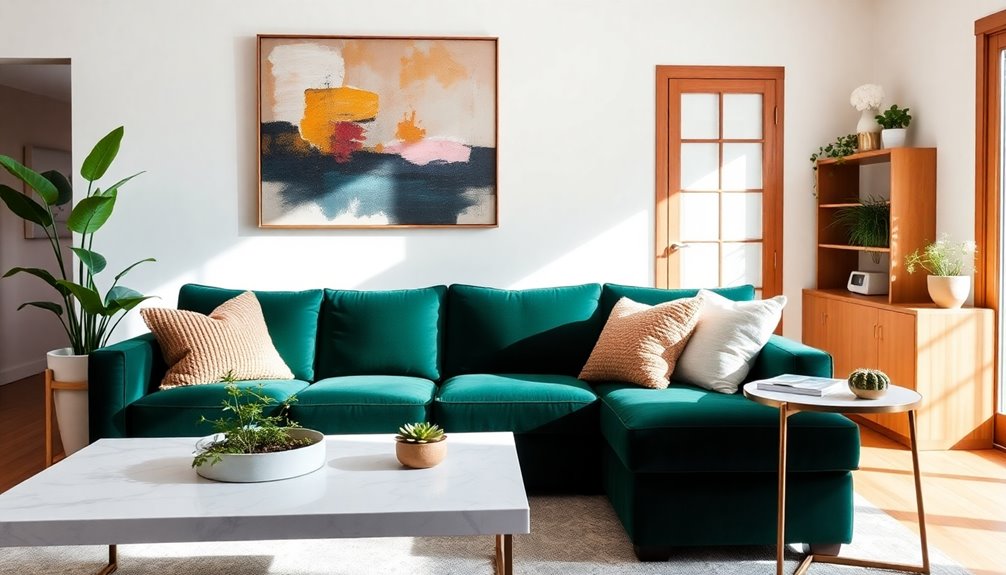Proper lighting over your dining table enhances the room’s ambiance and functionality by serving as a focal point. To achieve an inviting atmosphere, choose fixtures like chandeliers or pendant lights that complement your space, ensuring they hang about 30-36 inches above the table. Consider fixture size, style, and bulb warmth for ideal effect. Layering lighting with recessed or wall sconces further elevates your design. Continuing will reveal key tips to perfect your dining area illumination.
Key Takeaways
- Select a fixture that is 50-66% of the table’s width for proper proportion.
- Hang the light 30-36 inches above the table for optimal illumination and ambiance.
- Use warm white bulbs (2700K–3000K) to create a cozy, inviting atmosphere.
- Ensure the fixture is securely installed and properly wired for safety and stability.
- Incorporate layered lighting, such as dimmable fixtures and additional sources, for a versatile dining environment.

Have you ever considered the significance of your dining room as more than just a space for meals? It’s a central area where family and guests gather, where conversations flourish, and where memorable moments unfold. Given its importance, the lighting over your dining table warrants careful attention. Proper illumination not only enhances the aesthetic appeal but also influences the ambiance, functionality, and overall experience of dining. When selecting lighting, you should prioritize a fixture that offers both visual comfort and style, seamlessly complementing your room’s decor.
A well-chosen chandelier or pendant light becomes the focal point of your dining space. It should be proportionate to the table’s size—neither overwhelming nor insignificant. Typically, the fixture’s diameter should be about half to two-thirds the width of your table, ensuring it commands visual interest without obstructing sightlines. The height is equally critical; the bottom of the fixture should hang approximately 30 to 36 inches above the table surface. This height provides ample illumination while allowing unobstructed conversation and movement. Adjustments might be necessary based on ceiling height or personal preference, but maintaining a balance between form and function remains paramount.
The type of lighting fixture you choose influences the room’s atmosphere considerably. For a classic, elegant look, a crystal chandelier can add sophistication, casting shimmering reflections that elevate the dining experience. Conversely, a minimalist pendant in matte black or brushed metal can introduce modernity and subtlety, ensuring the lighting does not overshadow other design elements. When selecting the bulb type, opt for warm white light—around 2700K to 3000K—since it creates a cozy, inviting environment suitable for meals and conversation. Dimmable fixtures offer versatility, allowing you to adjust brightness according to mood, occasion, or time of day. Dimming capabilities also extend the lifespan of bulbs and contribute to energy efficiency.
Proper installation considerations are equally important. The fixture must be securely mounted to support its weight and positioned correctly above the table to provide even illumination. You should also ensure that electrical wiring complies with safety standards, especially if replacing an existing fixture. Proper wiring and professional installation prevent hazards and guarantee the fixture’s longevity. If your ceiling height permits, incorporating layered lighting—such as recessed lights or wall sconces—can add depth and dimension, highlighting your dining room’s architectural features. Additionally, choosing natural light sources or window treatments can enhance the overall ambiance during daytime meals.
Frequently Asked Questions
What Is the Ideal Height for a Dining Room Chandelier?
You should hang your dining room chandelier approximately 30 to 36 inches above the table’s surface. This height guarantees balanced illumination and visibility without obstructing views or conversation. Adjust the fixture’s length based on ceiling height—higher ceilings may require a longer chain, while standard ceilings benefit from the 30-36 inch range. Proper height enhances ambiance and functionality, creating an inviting and well-lit dining experience.
How Do I Choose Lighting for Different Table Sizes?
To choose lighting for different table sizes, you should consider the scale and proportion of the fixture. For small tables, opt for compact chandeliers or pendant lights that don’t overwhelm the space. For larger tables, select a fixture with a broader diameter or multiple lights to guarantee even illumination. Always ensure the fixture hangs 30-36 inches above the table surface to maintain balance, visibility, and ambiance.
Are Dimmable Lights Suitable for Dining Rooms?
Dimmable lights are highly suitable for dining rooms, as they offer adjustable brightness to suit various occasions and moods. You can create a cozy, intimate setting for romantic dinners or brighten the space for lively gatherings. Installing dimmers allows you to control light levels seamlessly, enhancing ambiance and comfort. Ensure your fixtures are compatible with dimmer switches to maximize their benefits and achieve ideal lighting flexibility during meals and events.
What Bulb Type Provides the Best Ambiance?
Think of your dining room as a stage, where the right bulb sets the mood. Warm LED bulbs, with a color temperature around 2700K to 3000K, offer a cozy, inviting ambiance perfect for intimate dinners. They mimic natural candlelight and reduce glare, creating an elegant atmosphere. Choosing dimmable warm LEDs allows you to fine-tune the lighting, ensuring your space always feels welcoming, adaptable, and refined.
How Often Should I Replace or Update My Dining Room Lighting?
You should replace or update your dining room lighting every 3 to 5 years, or sooner if you notice dimming, flickering, or the bulbs burning out frequently. Regular updates guarantee ideal ambiance, energy efficiency, and safety. Consider upgrading to modern fixtures or energy-saving bulbs, which can enhance aesthetics and reduce electricity costs. Periodic assessment of your lighting’s style and functionality helps maintain a welcoming and functional dining environment.
Conclusion
Ultimately, the lighting above your dining table acts as a guiding star, illuminating your gatherings with elegance and warmth. When thoughtfully chosen, it transforms an ordinary space into a sanctuary of connection and comfort, inviting conversations to flourish beneath its gentle glow. Like a masterful artist, your lighting design shapes the ambiance, casting a harmonious balance of light and shadow. Embrace this opportunity to craft an environment where every meal becomes a memorable moment bathed in refined illumination.








